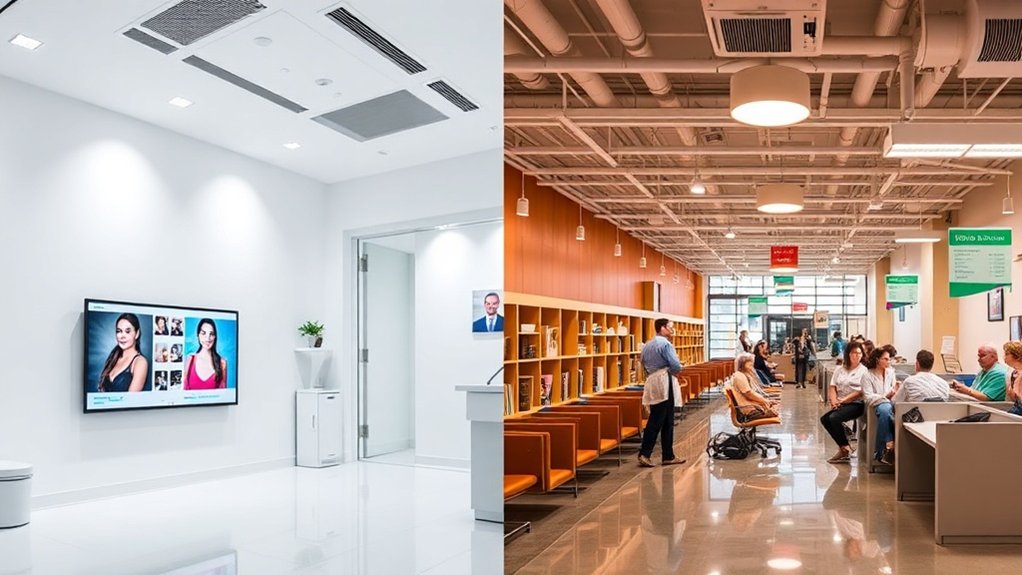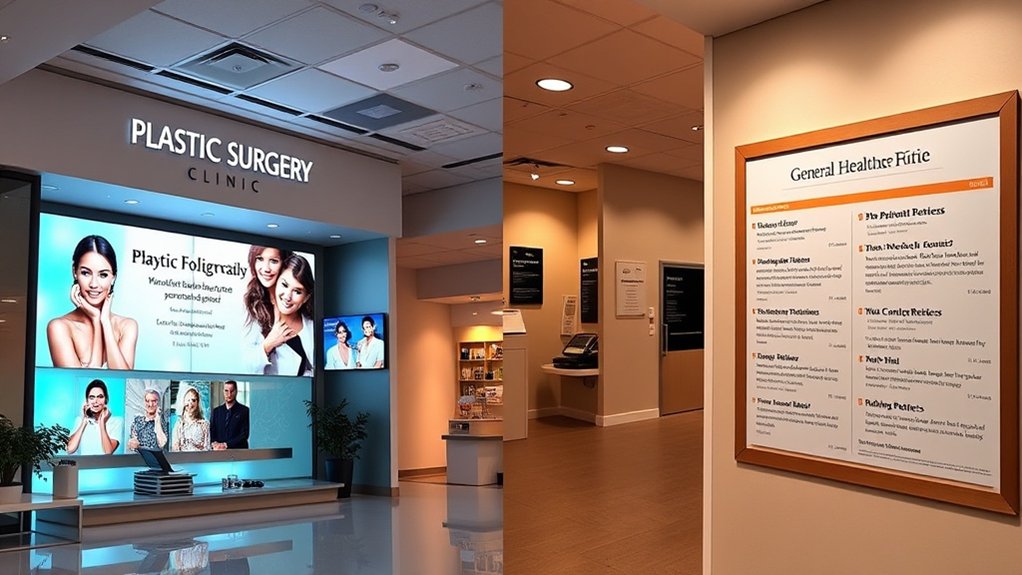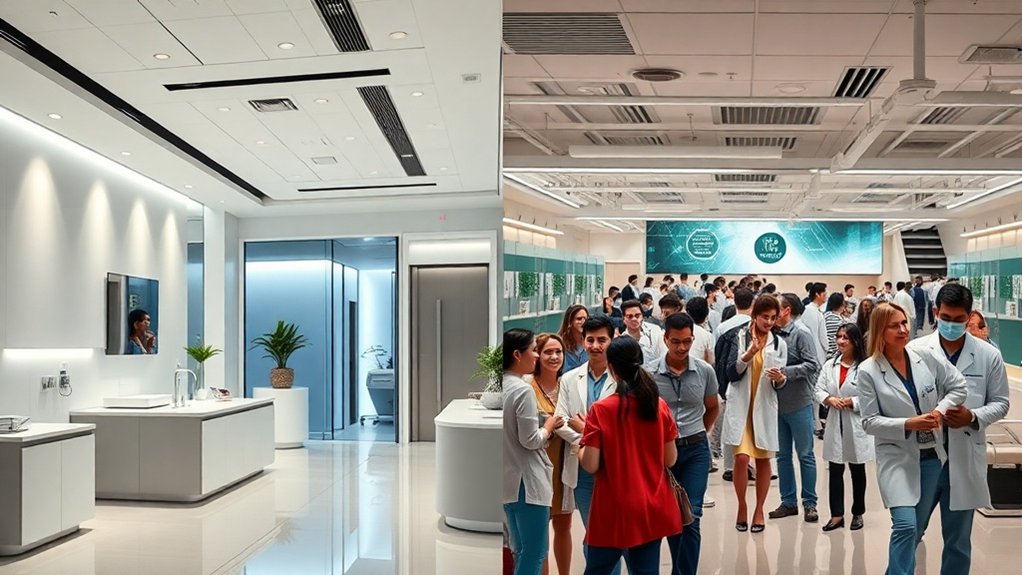Plastic surgery SEO targets high-intent, elective procedure searches with extensive visual content and longer patient decision cycles (3-6 months), while general healthcare SEO addresses immediate medical needs with broader educational content. You’ll need hyper-local optimization within a 15-mile radius for cosmetic practices versus wider geographic targeting for healthcare. Visual documentation, before-and-after galleries, and review management drive 91% of cosmetic patient conversions, compared to accessibility-focused content in traditional healthcare. The strategies, compliance requirements, and success metrics differ greatly between these specialized verticals, as you’ll uncover throughout this analysis.
Understanding the Fundamental Differences Between Plastic Surgery and General Healthcare SEO

While both plastic surgery and general healthcare practices compete for online visibility, their SEO strategies vary greatly due to distinct patient behaviors and market dynamics.
Plastic surgery SEO demands intensive visual content optimization, showcasing before-and-after galleries that general healthcare SEO doesn’t prioritize. You’ll need to focus on procedure-specific searches like “rhinoplasty surgeon” rather than broad medical terms, driving targeted traffic through high-intent keywords.
Local SEO and Google Business Profile optimization become critical for capturing nearby patients seeking elective procedures. Building patient trust requires extensive educational content and success stories, as prospects conduct thorough research before committing.
Additionally, you must direct stricter compliance and ethical marketing practices due to the elective nature of cosmetic services, distinguishing plastic surgery SEO from general healthcare SEO approaches.
Patient Intent and Decision-Making Journey: Elective vs. Necessity-Driven Searches
Understanding how these strategic differences manifest in practice requires examining the psychology behind patient searches and their path to conversion. When targeting elective procedures, you’ll find the decision-making journey extends considerably longer than necessity-driven searches. Patients research cosmetic surgery extensively, prioritizing trust and credibility through reviews and testimonials before committing.
| Search Aspect | Elective Procedures | Necessity-Driven |
|---|---|---|
| Patient Intent | High-intent keywords, comparison-focused | Immediate solution-seeking |
| Timeline | Extended research phase | Urgent, compressed |
| Content Needs | Educational resources addressing emotional aspect | Quick access information |
Your SEO strategy must accommodate this behavioral difference. Cosmetic surgery prospects need thorough content that builds confidence, while general healthcare focuses on accessibility and speed. This fundamental distinction shapes keyword targeting, content depth, and conversion optimization approaches.
Keyword Strategy Variations: Commercial Intent, Terminology, and Search Patterns

When developing keyword strategies for plastic surgery versus general healthcare, you’ll encounter fundamental differences in commercial intent that directly impact campaign performance.
Plastic surgery SEO demands specialized terminology targeting high-intent phrases like “breast augmentation near me,” while healthcare SEO employs broader medical terms. Your keyword strategy must account for distinct search patterns:
- Procedure-specific questions signal immediate booking intent, requiring trust-building content and patient testimonials.
- Localized keywords dominate the competitive landscape with terms like “top plastic surgeon in [city].”
- Credential-focused searches reflect extended research cycles demanding authority-building optimization.
- Commercial modifiers (“best,” “top-rated”) appear more frequently in cosmetic searches than general health questions.
These variations necessitate tailored approaches where plastic surgery SEO prioritizes conversion-driven, location-specific content while healthcare SEO addresses informational needs across broader geographic areas.
Content Requirements and Quality Standards for Each Healthcare Vertical
You’ll need to address distinct content requirements for each healthcare vertical, as plastic surgery demands extensive visual documentation and procedure-specific detail that general healthcare content doesn’t prioritize.
Your plastic surgery content must meet stringent medical advertising compliance standards while incorporating before-and-after galleries, detailed treatment protocols, and recovery timelines.
In contrast, your general healthcare content typically focuses on educational depth and clinical accuracy without the same emphasis on visual transformation documentation.
Procedure-Specific Content Depth
While general healthcare content can succeed with broader educational overviews, plastic surgery SEO demands granular, procedure-specific content that addresses the precise questions high-intent patients ask before committing to elective procedures.
Your thorough information must demonstrate trustworthiness and expertise while addressing patient concerns through educational resources that satisfy medical advertising regulations and ethical standards.
Your procedure-specific content should include:
- Detailed surgical technique explanations that demystify what happens during rhinoplasty or breast augmentation.
- Recovery timeline specifics with day-by-day expectations that reduce patient anxiety.
- Risk disclosures and complication management that build credibility through transparency.
- Cost breakdowns and financing options that address practical financial concerns.
Quality content for plastic surgery SEO means diving deeper than general healthcare topics, making certain your high-intent search inquiries lead to conversion-ready information.
Medical Compliance Standards
Because plastic surgery involves elective procedures with significant aesthetic and physical implications, your content faces heightened regulatory scrutiny that exceeds standard healthcare marketing compliance.
Medical compliance standards for plastic surgery SEO demand rigorous accuracy in claims, as misleading information triggers legal repercussions and reputation damage. You’ll need to craft patient testimonials following strict advertising guidelines, avoiding guaranteed results while building trust with potential patients.
Your before-and-after content must comply with HIPAA regulations through proper anonymization. Unlike general healthcare SEO, plastic surgery content requires balancing aesthetic and emotional aspects with clinical facts.
Ethical content isn’t optional—it’s foundational. Every claim needs substantiation through your surgeon’s credentials and expertise. This increased compliance framework protects both your practice and patients while differentiating you from general healthcare marketing approaches.
Visual Content Requirements
Beyond regulatory compliance, your plastic surgery practice faces distinct content demands centered on visual proof of expertise.
While healthcare SEO prioritizes educational articles, plastic surgery SEO requires high-quality visuals that drive patient engagement and conversion rates. Your before-and-after galleries serve as powerful trust-building tools, with websites featuring compelling aesthetic appeal experiencing 94% higher engagement than text-only platforms.
Your visual content strategy must balance these ethical marketing practices:
- Authentic patient transformations that showcase genuine results without manipulation
- Professional photography standards that highlight surgical precision and artistry
- Transparent presentation avoiding misleading expectations or exaggerated claims
- Strategic placement optimizing visibility while maintaining dignified patient representation
Unlike general healthcare SEO’s symptom-focused imagery, your practice demands aesthetically curated visuals that demonstrate technical skill while assuring compliance with advertising standards.
Local SEO Priorities and Geographic Competition Dynamics
Your plastic surgery practice faces fundamentally different local SEO challenges than general healthcare providers, requiring precise geographic targeting strategies that account for patients willing to travel 25-50 miles for elective procedures versus the 5-10 mile radius typical for primary care searches.
You’ll need to implement hyper-local market targeting that captures high-intent searches like “rhinoplasty surgeon in [neighborhood]” while simultaneously developing multi-location ranking strategies if you operate satellite offices or serve multiple metropolitan areas.
The competitive dynamics shift dramatically based on population density and competitor saturation, with metropolitan markets requiring aggressive local pack optimization and rural practices focusing on regional dominance across broader geographic territories.
Hyper-Local Market Targeting
Most plastic surgery practices draw 80-90% of their patient base from within a 15-mile radius, making hyper-local SEO targeting fundamentally different from general healthcare marketing strategies.
Your plastic surgery SEO success depends on dominating specific geographic areas with high-intent keywords that drive appointment bookings.
To maximize local search results visibility, you’ll need:
- Optimize Google Business Profile with specialty-specific categories and procedure highlights
- Target neighborhood-level keywords like “best plastic surgeon in [neighborhood]” rather than city-wide terms
- Generate authentic patient reviews across multiple platforms to build social proof
- Create location-specific landing pages for each service area you serve
These tailored SEO strategies guarantee you capture patients conducting mobile searches while actively seeking procedures, converting geographic proximity into competitive advantage for plastic surgeons.
Multi-Location Ranking Strategies
When managing plastic surgery practices across multiple locations, each office requires its own dedicated Google Business Profile with unique NAP data, service-specific content, and location-based keyword targeting to avoid ranking dilution.
Your multi-location ranking strategies must address geographic competition dynamics by tailoring high-intent keywords like “best plastic surgeon in [City]” to each market’s specific patient demographics.
NAP consistency across all online platforms is non-negotiable—discrepancies erode both search visibility and patient trust.
Build quality backlinks from local directories and reputable healthcare sources in each area to establish regional authority.
Monitor review patterns and engagement metrics per location to identify optimization opportunities.
This granular approach to local SEO guarantees each practice location competes effectively within its market while maintaining brand cohesion across your plastic surgery practices.
The Role of Visual Content, Reviews, and Social Proof in Conversion

While general healthcare practices can rely heavily on informational content to drive conversions, plastic surgery SEO demands a fundamentally different approach centered on visual proof and social validation.
Your conversion strategy must prioritize:
- Before-and-after galleries showcasing actual cosmetic procedures results
- Positive reviews influencing the 91% of consumers who research online ratings
- Patient success stories on platforms like RealSelf and Instagram
- High-quality visual content that extends user experience and improves SEO rankings
You’ll need compelling visual elements integrated with educational materials to address both aesthetic appeal and clinical credibility.
Social proof directly impacts conversion rates—search engines favor rich media that engages visitors longer.
Unlike general healthcare SEO’s text-focused approach, your plastic surgery practice requires this visual-first strategy combined with compliance-aware content to effectively convert high-intent patients into consultations.
Competitive Landscape Analysis: Market Saturation and Competitor Types
Understanding visual conversion strategies sets the foundation, but you’re operating in one of healthcare’s most saturated digital markets. The competitive landscape for plastic surgery SEO demands precision analysis of competitor types and market saturation levels affecting your online visibility.
| Competitor Type | Market Position | SEO Strategy Focus |
|---|---|---|
| Established Practices | Dominant local presence | Brand authority, reputation management |
| Emerging Clinics | Gaining market share | Localized SEO, niche markets targeting |
| Multi-Location Groups | Regional coverage | Google Maps optimization, procedure-specific content |
Patient search behavior for cosmetic procedures varies dramatically by location and procedure type. You’ll need localized SEO tactics addressing specific competitive dynamics—breast augmentation keywords face different saturation than facelifts. Monitor competitor types quarterly to adjust your positioning strategy effectively.
Compliance, Ethics, and Regulatory Considerations in Healthcare Marketing

Though visual appeal drives patient interest in plastic surgery, your marketing campaigns must operate within strict legal boundaries that don’t apply to general industries. Compliance with HIPAA regulations protects patient privacy, while medical advertising laws vary by state, dictating how you present results. Ethical marketing demands accuracy in representing credentials and outcomes.
Your regulatory considerations include:
- Patient consent requirements for testimonials and before-and-after images to avoid devastating legal repercussions
- State-specific restrictions on promotional claims that could shut down your campaigns overnight
- HIPAA compliance protocols that safeguard confidential patient information at every touchpoint
- Professional integrity standards that separate legitimate practices from questionable competitors
Specialized plastic surgery SEO agencies direct these complexities effectively, confirming your healthcare marketing maintains ethics while reaching potential patients. General SEO practitioners often overlook these critical compliance factors.
ROI Metrics and Performance Indicators: What Success Looks Like in Each Vertical
Because plastic surgery practices operate on high-value, elective procedures, your ROI metrics differ fundamentally from general healthcare metrics.
Plastic surgery SEO focuses on patient conversions and consultation bookings, with conversion rates reaching 10-15% versus 2-5% in general healthcare SEO. Your performance indicators center on procedure-specific keywords that increase qualified local traffic, while general healthcare prioritizes traffic volume across diverse services.
You’ll see observable ROI faster in plastic surgery—typically within 3-6 months compared to 6-12 months for general healthcare.
Some clinics report 800% ROI from targeted SEO efforts. Your success depends on tracking high-intent metrics: procedure bookings, consultation requests, and procedure-specific keyword rankings.
General healthcare SEO measures broader patient engagement and appointment scheduling across multiple specialties, requiring different performance indicators altogether.

